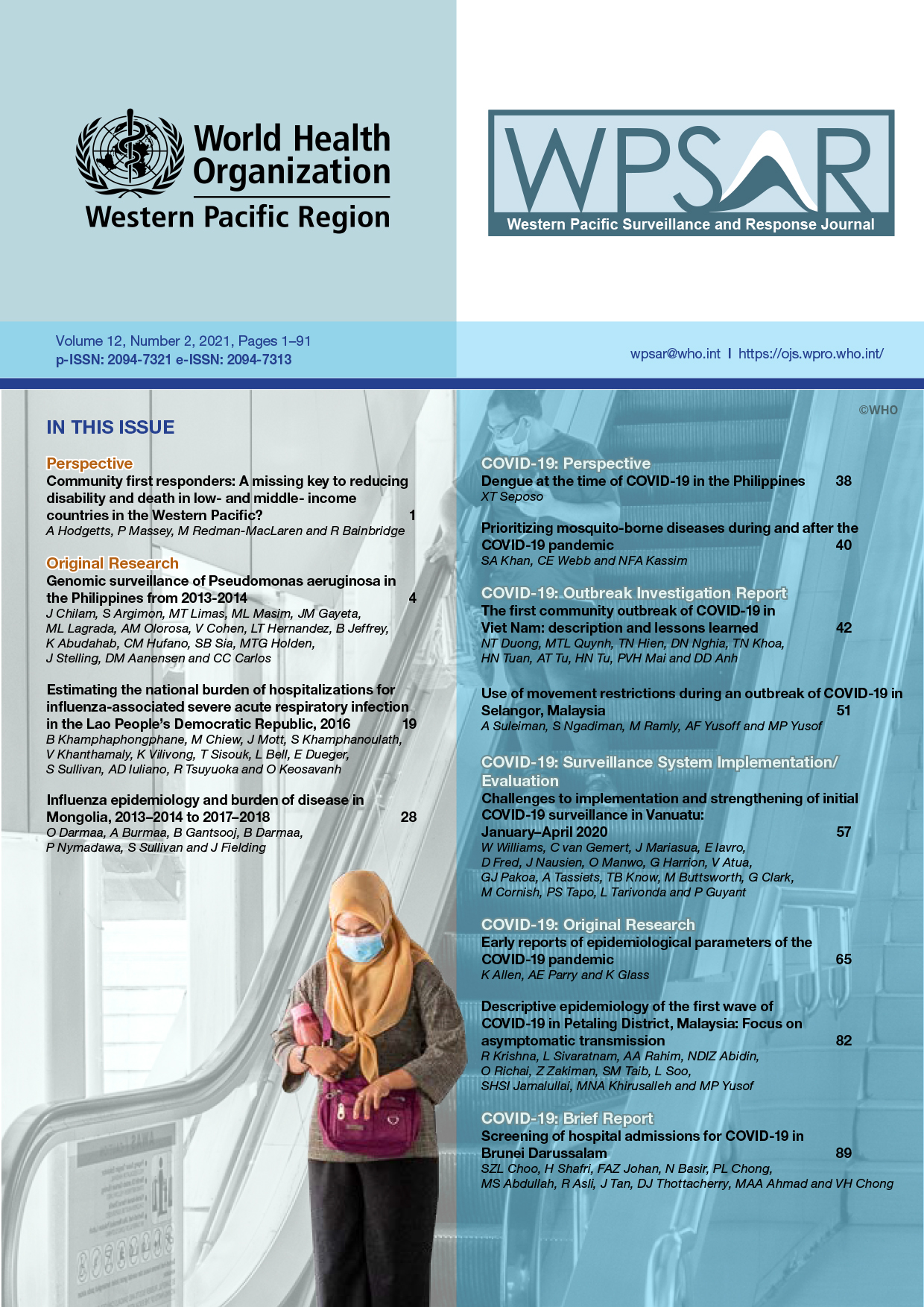Use of movement restrictions during an outbreak of COVID-19 in Selangor, Malaysia
DOI:
https://doi.org/10.5365/wpsar.2020.11.3.008Abstract
Objective: Various public health and social measures have been used during the COVID-19 outbreak, including lockdowns, contact-tracing, isolation and quarantine. The objective of this manuscript is to describe outbreaks of COVID-19 in Selangor, Malaysia, the public health strategies used and the observed impact of the measures on the epidemic curve.
Methods: Information on all confirmed COVID-19 cases in Selangor between 25 January and 28 April 2020 was obtained. Clusters were identified, and cases were disaggregated into linked, unlinked and imported cases. Epidemic curves were constructed, and the timing of movement control orders was compared with the numbers of cases reported.
Results: During the study period, 1395 confirmed COVID-19 cases were reported to the Selangor Health Department, of which 15.8% were imported, 79.5% were linked and 4.7% were unlinked cases. For two main clusters, the number of cases decreased after control measures were instituted, by contact-tracing followed by isolation and home quarantine for the first cluster (n = 126), and with the addition of the movement control order for the second, much larger cluster (n = 559).
Discussion: The findings suggest that appropriate, timely public health interventions and movement control measures have a synergistic effect on controlling COVID-19 outbreaks.
References
(WHO) WHO. Novel Coronavirus (2019-nCoV) Situation Report -1. 2020 21 January 2020. Report No.
Xu Z, Shi L, Wang Y, Zhang J, Huang L, Zhang C, et al. Pathological findings of COVID-19 associated with acute respiratory distress syndrome. The Lancet Respiratory medicine. 2020;8(4):420-2.
(WHO) WHO. World Health Organization; 2020 [cited 2020 22 April]. Available from: https://www.who.int/news-room/q-a-detail/q-a-coronavirus.
Li Q, Guan X, Wu P, Wang X, Zhou L, Tong Y, et al. Early Transmission Dynamics in Wuhan, China, of Novel Coronavirus-Infected Pneumonia. 2020;382(13):1199-207.
Linton NM, Kobayashi T, Yang Y, Hayashi K, Akhmetzhanov AR. Incubation Period and Other Epidemiological Characteristics of 2019 Novel Coronavirus Infections with Right Truncation: A Statistical Analysis of Publicly Available Case Data. 2020;9(2).
ACAPS. COVID-19: Governments Measures 2020 [cited 2020 3 June]. Available from: https://www.acaps.org/special-report/covid-19-government-measures.
Tobías A. Evaluation of the lockdowns for the SARS-CoV-2 epidemic in Italy and Spain after one month follow up. The Science of the total environment. 2020;725:138539.
Roy S. COVID-19 pandemic: Impact of lockdown, contact and non-contact transmissions on infection dynamics. medRxiv. 2020:2020.04.04.20050328.
Keeling MJ, Hollingsworth TD, Read JM. The Efficacy of Contact Tracing for the Containment of the 2019 Novel Coronavirus (COVID-19). medRxiv. 020:2020.02.14.20023036.
Furukawa NW, Brooks JT, Sobel J. Evidence Supporting Transmission of Severe Acute Respiratory Syndrome Coronavirus 2 While Presymptomatic or Asymptomatic. Emerging infectious diseases. 2020;26(7).
Quilty BJ, Clifford S, Flasche S, Eggo RM. Effectiveness of airport screening at detecting travellers infected with novel coronavirus (2019-nCoV). Euro surveillance : bulletin Europeen sur les maladies transmissibles = European communicable disease bulletin. 2020;25(5).
Nishiura H, Kamiya K. Fever screening during the influenza (H1N1-2009) pandemic at Narita International Airport, Japan. BMC infectious diseases. 2011;11:111.
Figueiredo A, Codina A, Marculino de Figueiredo DC, Saez M, León A. Impact of lockdown on COVID-19 incidence and mortality in China: an interrupted time series study2020.
Salim N, Chan WH, Mansor S, Bazin NEN, Amaran S, Mohd Faudzi AA, et al. COVID-19 epidemic in Malaysia: Impact of lock-down on infection dynamics. medRxiv. 2020:2020.04.08.20057463.
Flanders S, Nungsari M, Chuah HY. The COVID-19 Hardship Survey: An Evaluation of the Prihatin Rakyat Economic Stimulus Package2020.

